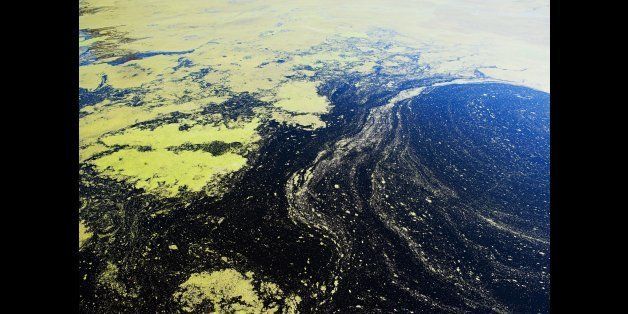
More than a century after regulations put a stop to California Gold Rush practices clouding the San Francisco Bay waters with silt, tidal movements have finally started clearing the water. However, that water clarity has made the bay a hotbed for algae blooms, threatening local marine life and posing expensive changes for the Bay Area.
A practice of blasting apart hillsides to mine gold was banned in 1884, but the resulting millions of tons of gravel and mud that settled in the bay as silt have remained a fixture in the ecosystem until recently, the San Jose Mercury News reports.
Now that the tides have moved most of the silt into the ocean, the bay’s clarity has dramatically improved.
"There is still some hydraulic mining sediment in the bay. It's not like it's all gone," David Schoellhamer, a U.S. Geological Survey hydrologist, told the Mercury News. "But the bay is establishing a new equilibrium."
However, the change may have launched the bay from the frying pan into the fire.
Clearer waters trap more sunlight, fueling the growth of algae, a type of phytoplankton. In the South Bay, growth is up 105 percent and as high as 300 percent in the summer, while in San Pablo Bay, growth is up 72 percent.
While algae is an important food source for clams and mussels and creates oxygen, an overabundance of it blocks the sunlight and uses up the oxygen on which the marine life living beneath the blooms rely.
To make matters worse, an increasing number of fish and crabs entering the bay are feasting on the clams and mussels that would otherwise keep the algae in check.
"Phytoplankton is like red wine," Jim Cloern, a senior scientist with the USGS, told the Mercury News. "A glass a day is good for our health, but a bottle a day is bad for our health. The question is where are we now between the glass and the bottle?"
The USGS shared these findings in 2007, urging other authorities to understand the connectivity between these processes.
That same year, a massive bloom of an ocean algae that produces a toxin killed hundreds of marine animals along the California coast, raising concern over algae overgrowth's other dangerous effects.
One solution may be cutting back on the nitrogen and phosphorous released into the bay through treated sewage water. Those excess nutrients fertilize the algae and might help spiral its growth, but updating the treatment process would come at a cost.
"If we do determine that something bad is happening and the wastewater treatment plants are the main cause, it's not like we can flip a switch overnight and upgrade all of these plants," Ian Wrenn, a hydrologist with the nonprofit Baykeeper, told the Mercury News.
While serious discussion of those regulations are a few years away, it could cost anywhere from $5 to $10 billion and increase Bay Area residents’ sewage bills.
"It's a very slow-moving process,” Wrenn said of the San Francisco Bay’s escalating problem. “But I think a lot of the treatment plants see the writing on the wall."
In total, the National Centers for Coastal Ocean Science estimate that harmful algal blooms across the U.S. cost $82 million a year, with most of those costs landing on commercial fisheries and the treatment of any resulting illnesses.
Those looking to understand the potential effects of algae overabundance can look to Lake Erie, where an excess of the slimy, green blooms on the water’s surface have been causing alarm since the 1960s. When the situation took a particular turn for the worse in 2011, concern turned to changes in agricultural practices that allowed for more fertilizer from fields to run-off into the lake.
The Chesapeake Bay, home to one of the first “dead zones” where so little oxygen exists that almost no life exists, is struggling to revitalize. Recent reports found that 70 percent of the bay’s water has fallen short of water quality goals as a direct result of the algae overabundance and other pollutants.

